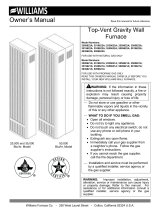
18
fumes or other chemicals which can cause
corrosion of the furnace combustion system.
Piping must be mechanically supported so that
its weight does not bear down on the furnace.
Supports must be at intervals no greater than
five feet, and at smaller intervals if necessary
to ensure that there are no sagging sections
to trap water (See Figures 16 & 17).
These condensing furnaces have been
certified for installation with zero clearance
between vent piping and combustible surfaces.
However, it is good practice to allow space for
convenience in installation and service.
Location of Outdoor Terminations
Vent and combustion air intake terminations
must be located to ensure proper furnace
operation and to conform to applicable codes.
Figure 15 illustrates necessary distances from
the vent termination to windows and building
air intakes. In Canada, the Canadian Fuel
Gas Code takes precedence over these
instructions. Specifically, all minimum
distance requirements with respect to
termination of the vent piping listed below.
The following list is a summary of vent terminal
location requirements:
1. The termination must be 12 inches above
snow level or grade level whichever is
higher. See Figure 18 for alternate method
to achieve 12" above snow level.
2. The minimum distance for a direct vent (2-
pipe) installation from any door, openable
window, or air gravity inlet is 1 ft. below, 1
ft. horizontally, or 1 ft. above.
3. The vent termination shall be a minimum of
3 ft. above any forced air inlet within 10 ft.
4. The vent termination shall be located at
least 4 ft. horizontally from any electric
meter, gas meter, regulator and any relief
equipment. These distances apply only
to U.S. installations. In Canada, the Can-
adian Fuel Gas Code takes precedence.
5. Avoid areas where condensate drainage
may cause problems by dropping on plant-
ers or patios, etc. Also ensure that ex-
haust gases will not impinge on windows
or building surfaces, which may be com-
promised or damaged by condensation.
Do not install the vent terminal such that
exhaust is directed into window wells,
stairwells, under decks or into alcoves or
similar recessed areas, and do not termi-
nate above any public walkways.
6. Select the point of wall penetration where
the minimum 1/4 inch per foot of slope up
can be maintained.
!
CAUTION:
For optimal performance vent furnace
through wall which experiences the least
exposure to winter winds.
Horizontal Venting
Vent and combustion air intake terminations
must be as shown in Figure 19 unless the
concentric vent termination kit is used.
!
WARNING:
Ensure that the combustion air vent and
the exhaust vent are configured as
shown in Fig. 19. Improper vent
termination can cause recirculation of
the flue gases. This may result in furnace
vibration. In severe cases, the furnace
will cycle, due to the intermittent contact
between the flame and the flame sensor.
If you note these oscillations occurring,
check the vent configuration. Make sure
that the exhaust vent does not have a 90
degree termination.
For horizontal venting, either the Horizontal
Exterior Vent Mounting Kit or the Concentric
Vent Termination Kit may be used (See Table
12).
For Canadian installations please refer to the
Canadian Installation Code (CAN/CGA-B149.1
or 2) and/or local codes.
The Horizontal Exterior Vent Mounting Kit con-
sists of two face plates and an insulating gasket
to seal the exterior surface. A hole sized closely
to the pipe diameter must first be cut through the
wall. A short length of pipe is then cut such that
it can penetrate the wall and be held in place by
closely fitting standard couplings. The face
plates are retained on both sides of the wall by





















